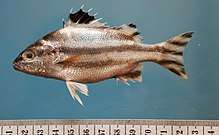Terapon theraps
Terapon theraps, the largescaled terapon, banded grunter, banded trumpeter, flagtail grunter, flagtail trumpeter, large-scaled grunter-perch, Northern grunter and spiky trumpeter, is a species of marine ray-finned fish, a grunter from the family Terapontidae. This species has a wide distribution in the Indo-Pacific region.
| Terapon theraps | |
|---|---|
 | |
| Scientific classification | |
| Kingdom: | Animalia |
| Phylum: | Chordata |
| Class: | Actinopterygii |
| Order: | Perciformes |
| Family: | Terapontidae |
| Genus: | Terapon |
| Species: | T. theraps |
| Binomial name | |
| Terapon theraps Cuvier, 1829 | |
| Synonyms[2] | |
| |
Description
Terapon theraps is a medium sized species of grunter which has an oblong body which shows moderate lateral compression. The jaws are of equal length and the mouth is slightly oblique, gape slightly oblique. In juveniles the maxilla is set level with the front of the eyes, it doesn't reach the eye in adults. The teeth are conical in shape and are arranged in villiform bands with the outermost row greatly enlarged. There are no teeth on the roof of the mouth. The dorsal fin has 11 o 12 spines and 9 to 11 soft rays, the spiny part is notably arched and has a deep notch. The third to the sixth dorsal fin spines are the longest and the notch is created by the second last spine being around half the length of the last spine. The anal fin has three spines and 7-9 soft rays, the longest spine being the third and this is longer than the longest ray, The caudal fin has a shallow fork and rounded lobes. The lateral line contains 46-56 pored scales.[3] This species is mainly dusky-green in colour with has a green iridescence which fades to silver-white on the belly. There are four broad dark, horizontal stripes along the flanks, a big black spot on the dorsal fin and dusky stripes on the tail. The juveniles are brown in colour and their stripes are darker and have white spots which run in lines in the paler areas between the dark stripes and they have a striped tail.[4] This species attains a maximum total length of 30 centimetres (12 in).[2]
Distribution
Terapon theraps is a widespread species in the Indo-Pacific region being found from the southern Red Sea and along the eastern coast of Africa as far south as Madagascar and eastwards along the southern Asian coasts, including the Seychelles, and into the Pacific Ocean where it reaches as far north as southern Japan and south to Australia and east to New Caledonia.[1] It has been recorded twice in the Mediterranean, once of Istria in the northern Adriatic Sea and once of Halkidiki in the Aegean Sea, as this species is not found in the northern Red Sea and the records are from more northerly areas of the Mediterranean well away from the Suez Canal it is thought that these records are of fish either transported by ships in ballast water or deliberate releases. It is also thought that these waters are too cold for this species to become established.[5]
Habitat and biology
Terapon theraps is a species of inshore waters in the tropics of the Indo-Pacific and it is common in brackish waters and among mangroves.[6] The juveniles frequently hide below floating algae and flotsam, particularly mats of Sargassum, and this can lead to wide dispersal.[4] It is an omnivorous species.[6] After spawning the male parent guards and fans the eggs.[2]
Fisheries
Terapon theraps is targeted by inshore fisheries using a wide variety of gear such as traps, handlines, and bottom trawls. It is normally marketed fresh but is sometimes preserved by drying or salting.[3]
References
- Allen, D.J. (2011). "Terapon theraps". IUCN Red List of Threatened Species. 2011: e.T187935A8639142. doi:10.2305/IUCN.UK.2011-1.RLTS.T187935A8639142.en. Retrieved 12 May 2020.
- Froese, Rainer and Pauly, Daniel, eds. (2019). "Terapon teraps" in FishBase. December 2019 version.
- R.P. Vari. "Terapontidae" (PDF). FAO. Retrieved 2 May 2020.
- Bray, D.J. (2016). "Terapon theraps". Fishes of Australia. Museums Victoria. Retrieved 12 May 2020.
- George Minos; Anastasia Imsiridou & Panos S. Economidis (2012). "First record of Terapon theraps (Terapontidae) in the Aegean Sea (Greece)". Cybium: international journal of ichthyology. 36 (2): 401–402.
- Mark McGrouther (26 June 2019). "Largescale Grunter, Terapon theraps Cuvier, 1829 The Largescale Grunter". Australian Museum. Retrieved 12 May 2020.
